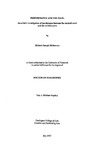PERFORMANCE AND THE PAGE: An artist's investigation of the dialogue between the musical event and the written score
| dc.contributor.author | McInerney, Michael Joseph | |
| dc.contributor.other | Faculty of Arts, Humanities and Business | en_US |
| dc.date.accessioned | 2011-10-03T12:48:34Z | |
| dc.date.available | 2011-10-03T12:48:34Z | |
| dc.date.issued | 2007 | |
| dc.identifier | Not available | en_US |
| dc.identifier.uri | http://hdl.handle.net/10026.1/826 | |
| dc.description.abstract |
This thesis is in two parts. Volume 1 is a discourse on notation and the musical event; Volume 2 contains a body of original works (scores, recordings and performance documentations). The relationship between the two is symbiotic; the works might be seen as exemplification of the ideas propounded in the written discourse, or the written discourse may be seen as providing an analytical context for the works as a consistent body of creative research activity. All the works in volume two were either created, or realised to performance, during the research period in which the discourse was written (November 1999 - September 2006). However, not everything created or performed during that time has been included; the choice of works to be included has been a judicious one of those which seem most pertinent to the topic of the thesis overall. The research process which this thesis summarizes might be described as a series of excursions, both theoretical and practical, into the space opened up by the incommensurability between the score as prescribing artefact and the musical event as historical and sensual fact. The intention has been to gain, or present, an overview of this space as a whole in order to make it available to myself as a site of independent creative activity. The primary field of research for the written discourse has been the body of works created within the concert tradition of the late twentieth century known collectively as `graphic scores'. Seen as a collective body, they provide variety of `takes' on the discursive space which arises between score and musical event. I have taken my critical methodology from a number of sources within twentieth century phenomenological thought and critical enquiry: most notably Heidegger's observations about temporality, Derrida's grammatology, Gadamer's hermeneutics and some of Peirce's observations about the nature of a sign. Surprisingly, the thesis has a conclusion: that the works of the Viennese composer Anestis Logothetis can be seent o representa radical re-assessment of the practice of realising musical events from written scores, one which retains the faithful reading whilst encouraging both an expanded sonic vocabulary and a greater stress upon the autonomy and independent musical practice of the interpreting performer. | en_US |
| dc.language.iso | en | en_US |
| dc.publisher | University of Plymouth | en_US |
| dc.title | PERFORMANCE AND THE PAGE: An artist's investigation of the dialogue between the musical event and the written score | en_US |
| dc.type | Thesis | |
| dc.identifier.doi | http://dx.doi.org/10.24382/4851 |
Files in this item
This item appears in the following Collection(s)
-
01 Research Theses Main Collection
Research Theses Main



